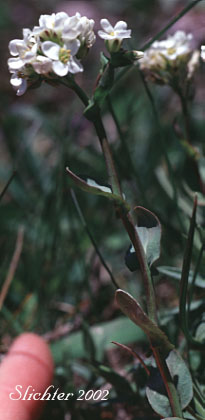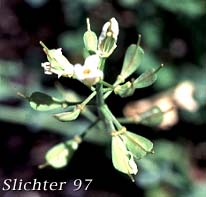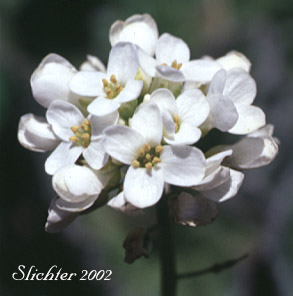 The
photo at right shows wild candytuft from Dog Mt., Columbia River Gorge, May 2002. Note the glaucous
appearance of the plant and the clasping bases to the leaves.
The
photo at right shows wild candytuft from Dog Mt., Columbia River Gorge, May 2002. Note the glaucous
appearance of the plant and the clasping bases to the leaves.
Rock penny cress is also known as glaucous penny cress. It is an attractive wildflower with one to several erect, simple to branched stems arising from 3-25 cm. The herbage is smooth and somewhat bluish-green in color. The numerous basal leaves may be found in a rosette, and several smaller leaves alternate up the stem. The basal leaves range from 1.5-4 cm long are oblanceolate in shape, tapering abruptly to a narrow petiole. The margins are entire or may have several teeth. The stem leaves are reduced in size and are lanceolate to oblong-elliptic, sessile, and auriculate or with clasping lobes at their base. The stem leaves measure from 5-35 mm long with entire margins.
The flowers have 4 white petals, from 4-6 mm long, with the 4 smaller sepals from 2-3 mm long. The thin pedicels are spreading to ascending and measure from 4-10 mm long. The seed capsules are elliptic in shape and acute at the tip, to heart-shaped with a notch at the tip (see photo below). The margins are keeled and thinly winged. The capsules measure from 4-10 mm long.Rock penny cress is a wildflower of open slopes and meadows. It is found from the valleys near sea level to open alpine regions in the mountains.
Rock penny cress is found west of the Rocky Mts. from British Columbia to Alberta and south to California and New Mexico.

